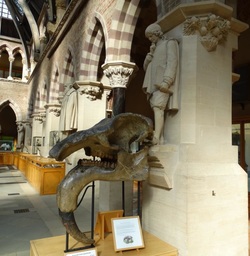The Natural History Museum
The Oxford University Museum is in itself a piece of history. The building is magnificent, and the statues of it's past patrons and contributors bring their discoveries to life. The columns of the gallery and hall are each made of a different British rock.
I was delighted to see collections of skeletons too.
I was delighted to see collections of skeletons too.
|
Wonderful skeletons arranged in order of height from Polar Bear to the Giraffe (not an adult) on the left and, on the right, starting with a pig going up to a camel. The elephants can be seen at the back, and are in the picture above. The Elephants are especially interesting. Observe the front 'forearm' with its twisted bones to take the weight while walking. In order, they are African, Asian and 3yr old Asian Elephant. |
|
Remains of the most recently discovered early human species, Homo floresiensis(nicknamed ‘Hobbit’), have been found between 95,000 and 17,000 years ago on the Island of Flores, Indonesia. H. floresiensis individuals stood approximately 3 feet 6 inches tall, had tiny brains, large teeth for their small size, shrugged-forward shoulders, no chins, receding foreheads, and relatively large feet due to their short legs. Despite their small body and brain size, H. floresiensis made and used stone tools, hunted small elephants and large rodents, coped with predators such as giant Komodo dragons, and may have used fire.
The diminutive stature and small brain of H. floresiensis may have resulted from island dwarfism—an evolutionary process that results from long-term isolation on a small island with limited food resources and a lack of predators. Pygmy elephants on Flores, now extinct, showed the same adaptation. The smallest known species of Homo and Stegodon elephant are both found on the island of Flores, Indonesia. However, some scientists are now considering the possibility that the ancestors of H. floresiensis may have been small when they first reached Flores. |
This museum, unlike many others, is not afraid of glass cases and as a result there are a great many interesting exhibits to explore. To the right of the Triceratops is a case of Pterodactyls and then Plesiosaurs. I had no idea Pterodactyls grew so enormous. Quetzalcoatus had a wingspan of 12m, the biggest living thing ever to fly.

















